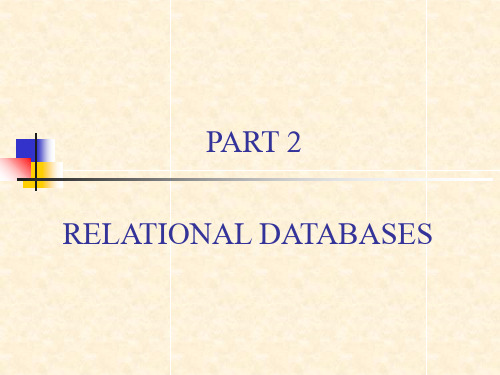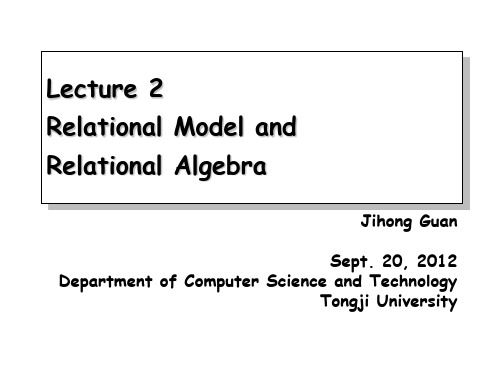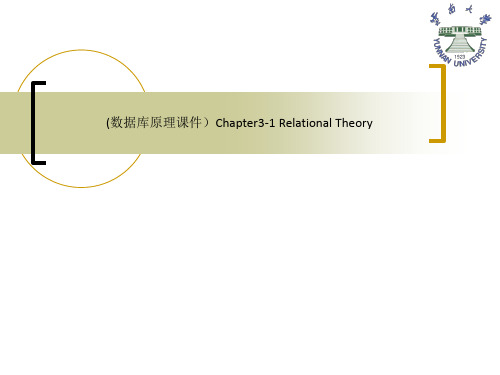数据库原理 英文课件Chapter3- The Relational Data Model
《数据库原理》PPT课件

精选ppt
12
2、软件
数据库系统的软件主要包括: (1)DBMS。DBMS是为数据库的建立、使用和 维护配置的软件。
(2)支持DBMS运行的操作系统。
(3)具有数据库接口的高级语言及其编译系统, 便于开发应用程序。
精选ppt
13
(4)以DBMS为核心的应用开发工具。 应用开发工具是系统为应用开发人员和最终用户
精选ppt
15
(1)数据库管理员(DataBase Administrator, DBA)
具体职责包括:
1)决定数据库中的信息内容和结构 2)决定数据库的存储结构和存取策略 3)定义数据的安全性要求和完整性约束条件 4)监控数据库的使用和运行
精选ppt
16
另外,在数据运行过程中,大量数据不断插入、 删除、修改,时间一长,会影响系统的性能。因此, DBA要定期对数据库进行重组织,以提高系统的性 能。
存储、检索和维护,它是数据处理的中心问题。
(2) 数据管理经历了三个阶段 .人工管理 .文件系统 .数据库系统
精选ppt
3
精选ppt
4
数据密集型应用(data intensive application)
数据密集型应用的特点
1.设及数据量大(TB),一般内存容纳不下,需放在 辅存; 2.数据为持久数据(persistent data); 3.数据为多个应用程序所共享,MIS、银行、办公系统、 网络数据服务等。
提供的高效率、多功能的应用生成器、第四代语言 等各种软件工具。它们为数据库系统的开发和应用 提供了良好的环境。 (5)为特定应用环境开发的数据库应用系统。
精选ppt
14
3.人员
开发、管理和使用数据库系统的人员主要是: 数据库管理员、系统分析员和数据库设计人员、 应用程序员和最终用户。不同的人员涉及不同的 数据抽象级别,具有不同的数据视图,有各自的 职责。
数据库原理及应用Principle and Application of Database第三章 关系.ppt

SELECT JNO FROM J WHERE NOT EXISTS (SELECT * FROM SPJ WHERE SPJ.JNO=J.JNO AND SNO IN (SELECT SNO FROM S WHERE CITY=‘天津’)); 或:SELECT JNO FROM J WHERE NOT EXISTS (SELECT * FROM SPJ,S WHERE SPJ.JNO=J.JNO AND SPJ.SNO=S.SNO AND S.CITY=天津’);
答:基本表是本身独立存在的表,在SQL中一个关系就对应一个 表。视图是从一个或几个基本表导出的表。视图本身不独立存 储在数据库中,是一个虚表。即数据库中只存放视图的定义而 不存放视图对应的数据,这些数据仍存放在导出视图的基本表 中。视图在概念上与基本表等同,用户可以如同基本表那样使 用视图,可以在视图上再定义视图。
⑸找出上海厂商供应的所有零件号码。
SELECT DISTINCT PNO FROM SPJ WHERE SNO IN (SELECT SNO FROM S WHERE CITY=‘上海’);
数据库原理及应用
8
朱辉生(jssyzhs@)
⑹找出使用上海产的零件的工程名称。
SELECT JNAME FROM J,SPJ,S WHERE J.JNO=SPJ.JNO AND SPJ.SNO=S.SNO AND S.CITY=‘上海’; 或:SELECT JNAME FROM J WHERE JNO IN (SELECT JNO FROM SPJ,S WHERE SPJ.SNO=S.SNO AND S.CITY=‘上海’);
AND PNO IN (SELECT PNO FROM P WHERE COLOR=‘红’));
数据库原理(双语)-Chapter03

Attribute
1. Relational Data Structure
Tuple (元组) is a row of a relation(关系的一行). Degree(度、目) is the number of attributes in a relation(属性数) Cardinality(基数) is the number of tuples in a relation(元组数). Relational Database (关系数据库) is a collection of normalized (规范化) relations with distinct relation names (关系名不同的若干规范关系的集合). Attribute Branch
Chapter 3 The Relational Model (关系模型)
3.1 3.2 3.3 3.4 Brief History of the Relational Model Terminology Relational Integrity/Integrity Constraints Views
3.1 Brief History of the Relational Model
Relational model was first proposed by E. F. Codd in his seminal(开创性的) paper „A relational model of data for large shared data banks‟ (Codd, 1970) (关系模型 由E. F. Codd 在其开创性论文“~”中首次提出). This paper is now accepted as a landmark in DBS(这篇 论文现在已被看成DBS发展过程中的一个地标). Relational model‟s objectives (关系模型的目标) : To allow a high degree of data independence. (允许高 度的数据独立性) To enable the expansion of set-oriented DML. (扩充面 向集合的DML)
《英文数据库》课件

2 数据表设计原则
探讨设计高效、规范的 数据表的方法。
3 实际案例分析
通过实际案例,演示数 据表设计的步骤和技巧。
数据库安全
1 安全威胁
详细介绍数据库面临的各种安全威胁。
2 安全保护措施
讨论数据库安全的最佳实践和保护措施。
3 实践案例分析
分析真实案例,探究数据库安全的实际应用。
对比NoSQL和SQL数据库的优点和局限性。
数据库管理
1 备份与恢复
探讨数据库备份和恢复 的策略和方法。
2 容灾与高可用
3 监控与维护
介绍保障数据库容灾和 高可用性的技术和方案。
分享数据库监控和维护 的最佳实践。
结语
数据库的未来发展和数据库管理者的职业前景展望。
《英文数据库》PPT课件
# 英文数据库 数据库的定义、分类和应用领域。
SQL语言
1 基本知识
介绍SQL语言的基本概 念和常用语句。
2 DML操作
探讨SQL语言中的数据 操作语句,如插入、更 新和删除。
3 DDL操作
讲解SQL语言中的数据 定义语句,如创建、修 改和删除表。
数据表设计
1 数据库范式理论
数据库性能优化
1 基本理念
介绍数据库性能优化的 核心思想和原则工具和技术。
3 性能优化技巧
分享提高数据库性能的 实用技巧和方法。
NoSQL数据库
1 基本概念
介绍NoSQL数据库的主要概念和特点。
2 应用场景
分析NoSQL数据库在不同场景下的应用优势。
3 对比分析
第3章关系数据库设计原理精品PPT课件

数据库管理系统
现实世界随着时间在不断地变化,因而在不同的时 刻,关系模式的关系也会有所变化。但是,现实世界的 许多已有事实限定了关系模式所有可能的关系必须满足 一定的完整性约束条件。
这些约束或者通过对属性取值范围的限定,或者通过 属性值间的相互关连(主要体现于值的相等与否)反映出 来。后者称为数据依赖,它是数据模式设计的关键,关 系模式应当刻划这些完整性约束条件。
数据的冗余度尽量低。 不出现插入、删除等操作异常; 能尽量如实反映现实世界的实际情况,而且又 易懂。 这就要求研究关系模式中各属性之间的依赖关 系,及其对关系模式性能的影响,探讨关系模式应 满足什么样的约束,这就是关系规范化的目的。
数பைடு நூலகம்库管理系统
关键字
学号 姓名 SNO sname
2001 李样
年龄 系 系主任 课程号
Cname)→Grade }
数据库管理系统
我们就得到了一个描述学校的数据库模式S〈U,F 〉:
U = { Sno,Sdept,Mname,Cname, Grade }
F = { Sno→Sdept,Sdept→Mname,(Sno ,Cname)→Grade }
数据库管理系统
3.2关系的规范化
设计一个的关系数据库,首先要定义一组关系, 这组关系定义的好,系统的性能就好,定义的差, 系统的性能就差。一般的设计原则是:
同样课程信息的操作也存在着插入异常、删除异常和数 据冗余。
数据库管理系统
上述问题出现的原因
上述问题的出现是因为在学生关系的属性之间存在
着数据依赖。
该关系的关键字是SNO(学号)+CNO(课程号)
属性dept(系)和mn(系主任)仅与SNO(学号)有关
[数据库原理]【英文版】Chapter03
![[数据库原理]【英文版】Chapter03](https://img.taocdn.com/s3/m/07424057ad02de80d4d8400a.png)
Chapter 3
The Relational Model
Relational Model Terminology
A relation is a table with columns and rows. – Two-dimensional table
» Rows: individual records » Columns: attributes
Foreign Key
– Attribute, or set of attributes, within one relation that matches candidate key of some (possibly same) relation.
13
14
Integrity Constraints
7 8
Mathematical Definition of Relation
Any subset of Cartesian product is a relation; e.g., a relation R = {(2, 1), (4, 1)} May specify which pairs are in relation using some condition for selection; e.g., – second element is 1: R = {(x, y) | x ∈D1, y ∈D2, and y = 1} – first element is always twice the second: S = {(x, y) | x ∈D1, y ∈D2, and x = 2y}
Dn .
» {A1: D1, A2: D2, …, An: Dn} is a relation schema » A relation R defined by a relation schema S is a set of mappings from the attribute names to their corresponding domains. » {A1: d1, A2: d2, …, An: dn} such that d1 ∈D1, d2 ∈D2, . . . , dn∈Dn
数据库系统原理(英文)811PPT课件

DB physical schema, e.g. physical storage structure and access method (chapter 11, 12)
April 2011
Fig. 6.0.1 DB design phases
Database System Concepts - Chapter8 Application Design and Development - 5
▪ As an integrity control mechanism, Trigger is introduced to SQL1999 standard, but supported even earlier using nonstandard syntax by most databases
April 2011
Application areas/problems in real worlds
Requirements analysis
Specification of user requirements (需求分析说明书)
Conceptual DB design
DB conceptual schema , i.e. E-R diagram (chapter 6)
April 2011
Database System Concepts - Chapter8 Application Design and Development - 9
宿主语言 + DML
用户A2
宿主语言 + DML
用户B1
宿主语言 + DML
用户B2
宿主语言 + DML
外模式 外部视图A
外部视图B
(数据库原理与应用课件)第三章关系数据库标准语言

准
语
言 ❖若一个记录有相关记录,那么便不能在主表中
SQL
更改其主键值;
第 四
15.创建关系
章
关
系 数
NorthWind数据库
据
库
标
产品
准
语
言
订单
客户
SQL
第 四 章
关 系 数 据 库 标 准 语 言
SQL
第
16.导入数据
四 章
关
系
数 据
库 标 准 语 言
SQL
演示导入Excel数据到数据库表向导…
据
库 标
❖ 3.1.2 SQL的特点
准
语 言
❖ 3.1.3 SQL的基本概念
SQL
第 四
3.1 SQL概述
章
关
系
❖ 3.1.1 SQL 的产生与发展
数
据 库
SQL :1974年提出,86年公布标准以来,不断发展
标
准 语
❖ 3.1.2 SQL的特点
言
SQL
❖ 3.1.3 SQL的基本概念
第 四
SQL标准的进展过程
第 四
3.面向集合的操作方式
章
关 系
❖ 非关系数据模型采用面向记录的操作方式,操
数 作对象是一条记录
据
库 ❖ SQL采用集合操作方式
标
准
➢ 操作对象、查找结果可以是元组的集合
语
言
➢ 一次插入、删除、更新操作的对象可以是元
SQL
组的集合
第
四
4.以同一种语法结构提供多种使用方式
章
关
系 ❖ SQL是独立的语言
SELECT
MISChapter 3

2. Data Definition Subsystem
• Data definition subsystem helps you create and maintain the data dictionary and define the logical structure of the tables (files) in a database • The data dictionary helps you define…
3. Database Management System Tools
• Database Management System (DMBS):
▫ System to specify the logical organization for a database and to access and use the information within a database
• OLAP
▫ Helps build business intelligence ▫ Supported by data warehouses and data-mining tools
1. OLTP & OLAP and BI
Agenda
1. 2. 3. 4. 5. 6. OLTP & OLAP The Relational Database Model Database Management System Tools Data Warehouses and Data Mining Business Intelligence Information Ownership
• Include logical ties within the information • Include built-in integrity constraints
数据库系统概论英文教材

数据库系统概论英文教材Data Management Systems: A Comprehensive OverviewData management systems have become an integral part of our digital landscape, enabling organizations to efficiently store, organize, and retrieve vast amounts of information. These systems, commonly known as database management systems (DBMS), have evolved significantly over the years, offering advanced features and capabilities that cater to the ever-growing demands of data-driven enterprises.At the core of a data management system lies the database, which serves as a centralized repository for structured data. Databases can take various forms, such as relational, NoSQL, or object-oriented, each with its own unique characteristics and use cases. Regardless of the specific type, the primary function of a database is to provide a secure, reliable, and scalable means of storing and managing data.One of the key components of a data management system is the database management system software, which acts as an intermediary between the database and the applications or users that interact with it. The DBMS provides a set of tools andfunctionalities that facilitate the creation, maintenance, and manipulation of the database, ensuring the integrity, security, and performance of the data.The DBMS typically includes features such as:1. Data Definition Language (DDL): This component allows users to define the structure of the database, including the creation, modification, and deletion of tables, indexes, and other database objects.2. Data Manipulation Language (DML): The DML enables users to perform operations such as inserting, updating, deleting, and querying data within the database.3. Transaction Management: The DBMS ensures the integrity of data by providing mechanisms for managing transactions, which are a series of operations that must be completed as a single, indivisible unit.4. Concurrency Control: This feature ensures that multiple users or processes can access and modify the same data simultaneously without compromising data integrity.5. Security and Access Control: The DBMS implements securitymeasures to protect the database from unauthorized access, data breaches, and other security threats.6. Backup and Recovery: The DBMS provides tools and procedures for regularly backing up the database and recovering data in the event of system failures or data loss.7. Query Optimization: The DBMS employs various techniques to optimize the execution of complex queries, ensuring efficient data retrieval and performance.Beyond the core DBMS functionalities, modern data management systems often incorporate additional components and technologies to enhance their capabilities. These may include:1. Data Warehousing: Data warehouses are specialized databases designed for analytical and reporting purposes, enabling organizations to consolidate and analyze large volumes of data from various sources.2. Business Intelligence (BI) and Analytics: BI tools and analytical capabilities integrated with the data management system allow organizations to extract insights, identify trends, and make data-driven decisions.3. Big Data Management: With the exponential growth of data, data management systems have evolved to handle large-scale, unstructured data, often leveraging technologies such as Hadoop, NoSQL databases, and stream processing.4. Cloud-based Data Management: The rise of cloud computing has led to the development of cloud-based data management services, offering organizations the flexibility, scalability, and cost-effectiveness of managing their data in the cloud.5. Data Governance and Metadata Management: Effective data management requires comprehensive data governance policies and metadata management, ensuring the quality, security, and compliance of data across the organization.As organizations continue to generate and collect vast amounts of data, the importance of robust data management systems cannot be overstated. These systems play a crucial role in enabling organizations to harness the power of their data, drive informed decision-making, and gain a competitive edge in the digital landscape.In conclusion, data management systems are the backbone of modern data-driven organizations, providing the necessary tools and infrastructure to store, manage, and leverage data effectively. Byunderstanding the core components and capabilities of these systems, organizations can optimize their data management strategies and unlock the full potential of their data assets.。
数据库原理24学时英教ppt课件

– There may be many external schemas in a DB.
• Schema(模式): conceptual schema, logical schema
– Defines data from perspective systems designer;
– Independent of end users & data storage mechanism
?基本概念数据库的概念数据库管理系统的概念和功能数据库系统的概念和组成数据管理技术的发展?数据模型概念模型及er图表示方法数据模型的三大要素数据库领域中常用的数据模型关系模型的数据结构主要操作完整性约束?数据库系统结构数据库的三级模式结构体系结构数据独立性的概念及实现?关系数据库关系数据结构及形式化定义?域笛卡尔积关系主码外码关系模式关系代数运算符使用关系代数描述用户查询?sql语言sql语言的特点sql命令及使用?关系数据理论函数依赖等基本概念1nf2nf3nfbcnf的定义和判断关系模式设计不好可能出现的问题?数据库设计设计er图并转换为关系模式?事务事务的概念及特性?数据库恢复数据库恢复机制的功能故障种类及对数据库可能造成的影响恢复的实现技术备份日志?并发控制并发控制机制的功能并发调度的可串行性的定义封锁的概念?数据库安全性的概念及安全控制技术basicnotions?databasedbinessenceitsnothingmorethanacollectionofinformationthatexistsoveralongperiodoftime
Internal Schema Reflection, so application programs
needn’t been changed. 精选编辑ppt
数据库系统概念原书第5版(英文)第二章ppt

Jones Smith Curry Lindsay
Main North North Park
customer
Harrison Rye Rye
Pittsfield
tuples (or rows)
July 25, 2021
r(R) is a relation on the relation schema R
E.g. customer (Customer_schema)
July 25, 2021
Dept. of Comp. Sci. & Tech., Tongji Uni.
8
Relation Instance (关系实例)
available and legal values of the attribute Attribute values are (normally) required to be atomic
E.g. multi-valued attribute values are not atomic E.g. composite attribute values are not atomic The special value null is a member of every domain The null value causes complications in the definition of many operations
July 25, 2021
Dept. of Comp. Sci. & Tech., Tongji Uni.
7
Relation Schema (关系模式)
(数据库原理课件)Chapter3-1 Relational Theory

Weak Entity
A dependent table (also called a weak entity) is a child table that requires a parent table for identification.
Database Design. SchoEoxlhoibf ist o2f-t7w:aPrerimary Keys Formed from
11
Existing Fields
Computer-Generated Primary Keys
Exhibit 2-8: Computer-Generated Primary Keys
Database Design. School of software
5
Many-to-Many Relationships
A many-to-many relationship is represented by creating an associative entity.
Database Design. SchoEoxlhoibf ist o2f-t3w:aMreany-to-Many Relationships
(数据库原理课件)Chapter3-1 Relational Theory
Objective
Describe the relational model. Identify the symbols used in an ER diagram. Define and select a primary key. Explain the role of foreign keys. Identify and apply integrity rules. Explain the advantages of relational database.
数据库英文PPT课件

第8页/共45页
Example: Deletion
• Delete from relation StarsIn the fact that Sydney GreenStreet was a star in The Maltese Falcon:
DELETE FROM StarsIn WHERE movieTitle = ‘The Maltese Falcon’ AND
value, the value that is placed in a component if no other value is known.
23
第23页/共45页
Example
• We might wish to use the character ‘?’ as the default for an unknown gender, and we might also wish to use the earliest possible date, DATE ‘0000-00-00’ for an unknown birthdate.
22
第22页/共45页
Default values
• When we create or modify tuples, we sometimes don’t have values for all components.
• To address this problem, SQL provides the NULL value. • However, there are times when we would prefer to use default
1. Insert a tuple or tuples.
2. Delete a tuple or tuples.
- 1、下载文档前请自行甄别文档内容的完整性,平台不提供额外的编辑、内容补充、找答案等附加服务。
- 2、"仅部分预览"的文档,不可在线预览部分如存在完整性等问题,可反馈申请退款(可完整预览的文档不适用该条件!)。
- 3、如文档侵犯您的权益,请联系客服反馈,我们会尽快为您处理(人工客服工作时间:9:00-18:30)。
The things you should know…
The basic principle of relational database is proposed by E.F.Codd in 1970. The first RDBMS production is System R The most popular RDBMS
5
Attributes (属性)
Attributes of a relation serve us as names for the columns of the relation. Usually, the attributes describes the meaning of entries in the column below.
11
An Example of Relation Instance
Relation: Person (Name, Address, Telephone)
Relation Instance:
Name
Address
Telephone
Bob
123 Main St
555-1234
Bob
128 Main St
Example: Movies (title, year, length, fileType)
Database schema = a set of all relation schemas
Movies(Title, Year, Length, FileType) Star(Name, Age) Studio(StudioName, Addr)
6
Schemas(模式)
The name of a relation and the set of attributes for a relation is called the schema for that relation. We show the schema for the relation with the relation name followed by a parenthesized list of its attributes.
7
Tuples(元组)
The rows of a relation, other than the header row containing the attributes, are called tuple. For example:
Relations, however, are sets of tuples, and it is impossible for a tuple to appear more than once in a given relation.
8
Domains(域)
The relational model requires that each component of each tuple be atomic; that is, it must be of some elementary type such as integers or string. Each attributes of a relation has particular elementary type, thus domain is decided.
9
Equivalent Representations of a Relation
The attributes of the relation can be reordered without change the relation.
10
Relation Instance(关系实例)
A relation about movies is not static; rather, relations change over time. It is not common for the schema of a relation to change. We shall call a set of tuples for a given relation an instance of that relation.
Contents
3.1 Basics of the Relational Model 3.3 From E/R diagrams to Relational Designs 3.5 Functional Dependencies 3.7 Design of Relational Database Schemas Reading Guide Exercise
13
Name Addr Tel
N1 A1 T1
N2 A2 T2
N3 Байду номын сангаас3 T3
N4
T4
N5
T5
T6
T7
Domai n
Attribute
Name Addr Tel N1 A1 T1 N1 A1 T2 N1 A1 T3 Component
. . .
N1 A1 T7 N1 A2 T1 N1 A3 T1 Tuple N2 A1 T1
555-1235
Pat
123 Main St
555-1235
Harry
456 Main St
555-2221
Sally
456 Main St
555-2221
Sally
456 Main St
555-2223
Pat
12 State St
555-1235
12
More …
Relation (Instance) = a set of tuples Database = collection of relations Relation schema = relation name + attributes
• DB2, Oracle, Ingres, Sybase, Informix,…
4
3.1 Basic of the Relational Model
The relational model gives us a single way to represent data: as a two- dimensional table called a relation.
